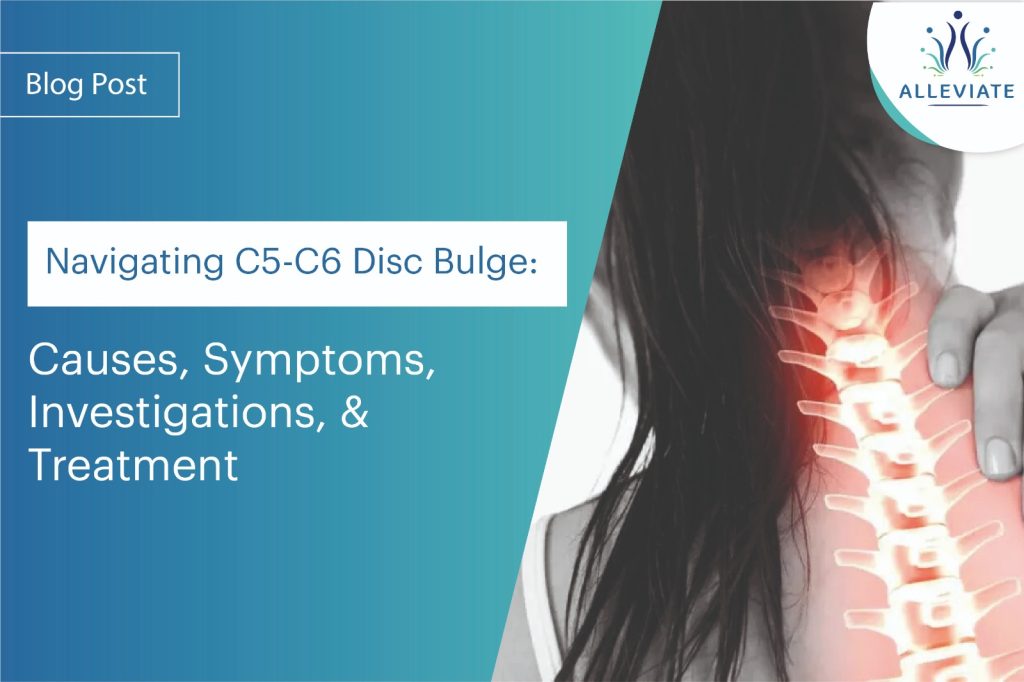Introduction
The spine is a complex and delicate structure that can be susceptible to various issues, including disc bulges. One common area affected is the C5-C6 level, where the fifth and sixth cervical vertebrae meet. In this blog, we delve into the intricacies of C5-C6 disc bulges, exploring their causes, symptoms, diagnostic investigations, and treatment options with a spotlight on image-guided injection-based treatments.
Causes of C5-C6 Disc Bulge
C5-C6 disc bulges often result from wear and tear over time, a condition known as degenerative disc disease. As the discs between the vertebrae lose their hydration and elasticity, they become more susceptible to bulging. Additionally, factors like poor posture, improper lifting techniques, and repetitive strain on the neck can contribute to the development of disc bulges.
Symptoms
The symptoms of a C5-C6 disc bulge can vary based on the degree of compression on nearby nerves or spinal cord structures. Common symptoms include:
- Neck Pain : Dull or sharp pain at the back of the neck.
- Radiating Arm Pain : Pain that travels down the arm, often following the path of the affected nerve.
- Numbness and Tingling : Sensations of numbness or tingling in the shoulder, arm, or hand.
- Muscle Weakness : Weakness in the muscles of the shoulder, arm, or hand, impacting grip strength and coordination.
Investigations
Diagnosing a C5-C6 disc bulge involves a comprehensive approach, often including:
- MRI Scan : Magnetic resonance imaging provides detailed images of the spine, allowing doctors to visualize the disc bulge’s size, location, and impact on surrounding structures.
- X-rays : X-rays help assess the alignment of the vertebrae and detect any changes that might be contributing to the bulge.
- Physical Examination : A thorough physical examination can help doctors assess range of motion, muscle strength, and reflexes, providing additional insights into the condition.
Treatment Options
Treatment for a C5-C6 disc bulge depends on the severity of symptoms and the impact on a patient’s daily life. Some treatment options include :
- Conservative Approaches : Rest, physical therapy, and pain medications can help manage mild symptoms and improve overall neck health.
- Image-Guided Injections : In more severe cases, image-guided injections can offer targeted relief. Techniques like epidural steroid injections can deliver anti-inflammatory medication directly to the affected area, reducing pain and inflammation.
- Surgery : Surgical intervention might be considered if conservative treatments do not provide relief. Procedures like discectomy or fusion aim to alleviate pressure on the affected nerve or spinal cord.
The Role of Image-Guided Injections
Image-guided injections, such as epidural steroid injections, play a crucial role in managing symptoms related to C5-C6 disc bulges. By using fluoroscopy or ultrasound, healthcare providers can accurately guide the needle to the precise location of the bulge. The injected medication, often a combination of a steroid and a local anesthetic, targets inflammation and provides relief to the affected nerve roots. AT ALLEVIATE, we follow a multidisciplinary approach of image guided interventions with a structured physical therapy programme.
References
- Dydyk AM, Ngnitewe Massa R, Mesfin FB. Disc Herniation. [Updated 2023 Jan 16]. In: StatPearls [Internet]. Treasure Island (FL): StatPearls Publishing; 2023 Jan-. Available from: https://www.ncbi.nlm.nih.gov/books/NBK441822/
- Dydyk AM, Sekhri N. Cervical Epidural Injection. [Updated 2023 Apr 24]. In: StatPearls [Internet]. Treasure Island (FL): StatPearls Publishing; 2023 Jan-. Available from: https://www.ncbi.nlm.nih.gov/books/NBK557771/



